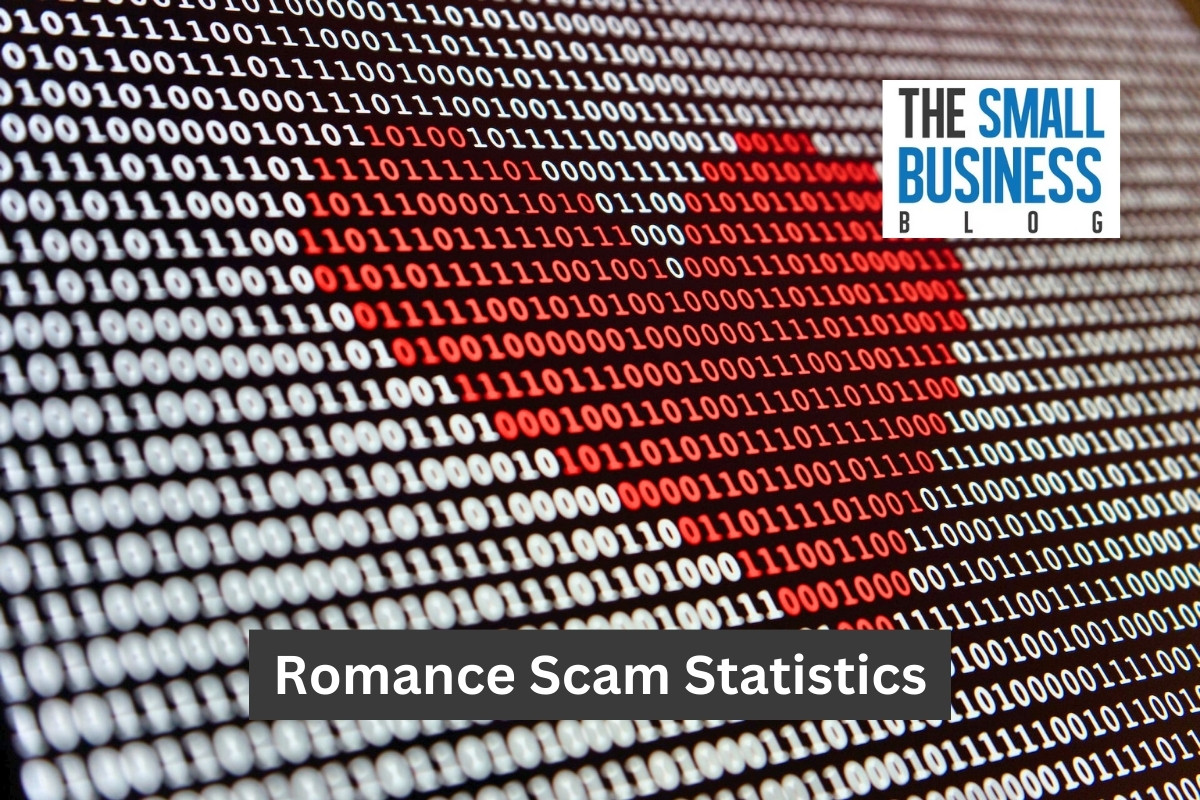Love has always been one of the most common tricks people use to deceive others.
And now that online dating is one of the most common ways to meet the love of your life, romantic scams are becoming more prevalent in invading and ruining one’s lives.
Millions of people are becoming prey to these romance scams each year.
The numbers are continuously increasing as the years pass.
Romance scams are sort of internet frauds in which the con artists make fictitious online personas in an effort to win the love and trust of their prospect.
Most scammers use online dating websites and platforms, social media, and email to find their victims.
They build fictitious profiles with a broad appeal.
They might represent themselves as doctors, soldiers, or accomplished merchants, they can literally be whoever they want.
In this article, we will explore some romance scams statistics including how much is lost to romance scams, how many romance scam victims there are, and who are the most common victims of these romance scams.
Post Contents
- 1 Key Statistics
- 2 General Romance Scams Statistics
- 2.1 1. Over 1.3 billion dollars were lost to romance scams in 2022
- 2.2 2. Online romance scams are one of the most common types of fraud in the US
- 2.3 3. More than 55,000 people reported suffering from romance scam in 2021
- 2.4 4. In 2021, more than 36,000 victims claimed that scammers used social media to deceive them
- 2.5 5. 50.3% of romance scam victims are women
- 2.6 6. About 60% of online profiles are fake or inactive
- 2.7 7. 337 million individuals are using dating apps worldwide
- 2.8 8. There are more than 57 million users of dating apps in the US
- 2.9 9. One in five male dating profiles is likely to be fake
- 2.10 10. Financial losses from romance scams increased by more than 80% from 2020 to 2021
- 2.11 11. Online fraud has increased by over 25% since the beginning of 2019
- 2.12 12. People between the ages of 55 and 64 are the most likely to be targeted by romance scams.
- 2.13 13. A 2019 report by the FTC found that Americans over 65 lost $84 million to romance scams
- 2.14 14. People are 52% more likely to fall victim to fraud on Valentine’s Day
- 2.15 15. One in five con artists uses Facebook
- 2.16 16. In the United Kingdom, the average person loses £11,796 to romantic scams
- 2.17 17. In 2021, Californians lost nearly $184 million to dating scams, more than any other state in the US
- 2.18 18. Victims of romance scams in 2022 lost the most money to cryptocurrency scams, with 34% of all reported losses
- 2.19 19. People over 65 reported more than 49,000 romantic scams.
- 2.20 20. Lies scammers love to tell
- 3 Quick signs to know if your online lover is a scam
- 4 How do romance scams work?
- 5 Conclusion
Key Statistics
- Over 1.3 billion dollars were lost to romance scams in 2022.
- Online romance scams are one of the largest types of fraud in the US.
- Women make up 50.3% of romance scam victims.
- Since 2019, there has been a roughly 25% rise in online frauds.
- In 2019, romance scams cost older citizens in the US $84 million.
- Romance fraud targets people between the ages of 55 and 64.
- Valentine’s Day increases people’s vulnerability to scams by 52%.
- Facebook is used by 21% of con artists.
- Cryptocurrency loss is a documented result of 34% of romance scams.
- The typical person in the UK loses £11,796 to romance scams.
- Over 49,000 cases of romance fraud are reported by people 65 and older.
General Romance Scams Statistics

1. Over 1.3 billion dollars were lost to romance scams in 2022
According to romance scams statistics in 2022, there were an estimated 70,000 reports of romance scams, resulting in losses of over $1.3 billion.
This represents an increase of nearly 80% from 2020’s figure.
These scammers construct fictitious online personas and exploit them to win the love and trust of their targets.
These scammers have a lot of strategies, including love bombing, disclosing private information, and making unreliable promises, to win the victim’s confidence.
The scammer will then start to demand some money or other valuables once they’ve won the victim’s trust.
(Federal Trade Commission)
2. Online romance scams are one of the most common types of fraud in the US
Romance scams are a major problem in the United States.
American victims lost about hundreds of millions of dollars each year.
In 2022 alone, people lost about $304 million to these scammers.
(ZD Net)
3. More than 55,000 people reported suffering from romance scam in 2021
Despite people being more knowledgeable about these online scams, romance scams continue to become a growing problem worldwide.
In 2021, over 55,000 people reported being a victim of romance scams.
There are several reasons why online romance scams are still prevalent in today’s technological age.
One reason is the increasing popularity of online dating.
After the pandemic, a lot of people shifted to online dating as it is the only way to meet people anywhere from the world due to lockdown restrictions.
As more and more people turn to online dating to find love, scammers have more opportunities to target potential victims and make them believe that they are the one for them.
(FTC)
4. In 2021, more than 36,000 victims claimed that scammers used social media to deceive them
According to recent reports, over 4.9 billion people are using social media in 2023, almost half of the global population.
These platforms have become a prime hunting ground for romantic scammers.
In 2021, more than 36,000 victims claimed that social media is the main medium scammers used to deceive and contact them.
Scammers use social media to create fake profiles and target potential victims with false promises of love and companionship.
Once they have gained the victim’s trust, they will ask for money or other valuables and use it against their victims.
(FBI)
5. 50.3% of romance scam victims are women

According to recent data, women are more likely to use dating apps than men.
Nearly 32% of women used dating apps once in their lives.
Due to this, they are more likely to be the victims of online romance scams.
About 50.3% of romance scam victims are women.
Scammers often target women who are looking for love and companionship online.
They create a fictitious story that captures a woman’s attention and often love bombs them until they get what they want.
(Scamwatch)
6. About 60% of online profiles are fake or inactive
Different social media sites have a large number of inactive or fake online profiles.
Approximately 60% of online profiles are either fake or inactive.
There are several reasons for this.
One is that making fake profiles on social media is incredibly simple.
The majority of platforms simply need a few simple bits of data, including an email address and a username.
This makes it simple for scammers to build bogus profiles and target unsuspecting people for their advantage.
(Proprivacy)
7. 337 million individuals are using dating apps worldwide
Dating applications have been quite popular recently, especially after the surge of pandemic.
Over 337 million individuals are using dating apps globally.
Nowadays, using dating apps is a more practical way to meet new people wherever you are.
With just a few clicks, you can quickly establish a profile and begin searching for your one true love aka matches.
Regardless of your location, it enables users to connect with individuals from all over the world.
(Business of Apps)
8. There are more than 57 million users of dating apps in the US
In 2023, about 17.6% of the United States’ population or about 57 million Americans are using dating apps.
In recent years, the stigma attached to internet dating has been diminished.
Online dating is increasingly seen as one of the most common ways of meeting new people and building connections with them.
(Statista)
9. One in five male dating profiles is likely to be fake
Men are more likely to create fake dating profiles.
Male dating profiles are 21% more likely to be fake than female dating profiles.
As mentioned earlier, women are more likely to be victims of these romance scams.
Men create fake online dating profiles in order to target women for scams, such as romance scams or investment scams.
Most of them create fake profiles in order to catfish women, or to deceive them into believing that they are someone they are not.
(Digital Shred)
10. Financial losses from romance scams increased by more than 80% from 2020 to 2021
According to the Federal Trade Commission (FTC), between the years 2020 and 2021, romance scam losses climbed by more than 80%.
In addition, the amount of money lost due to romance scams climbed dramatically, rising from $547 million in 2020 to $1 billion in 2021.
(FTC)
11. Online fraud has increased by over 25% since the beginning of 2019
Since the beginning of 2019, online fraud has surged by more than 25%.
Different kinds of internet scams have become more prevalent for a variety of reasons.
Now that more people are shifting their activities from offline to online, internet scammers are gaining more opportunities to deceive more and more vulnerable people.
(FBI)
12. People between the ages of 55 and 64 are the most likely to be targeted by romance scams.

According to reports, people between the ages of 55 and 64 are at the highest risk of being victims of romance fraud.
The likelihood of loneliness or isolation increases with age.
As a result, older people are more prone to the love and attention these scammers are offering.
Older people are more likely to be targets of financial scams because they are more likely to have financial resources like savings or pensions.
(BBB Institute for Marketplace Trust)
13. A 2019 report by the FTC found that Americans over 65 lost $84 million to romance scams
The Federal Trade Commission (FTC) estimates that Americans over 65 years old lost more than $84 million to romance scams in 2019.
Scammers are often skilled at manipulating people and can prey on the emotions of their victims.
Aside from being more lonely and isolated, older people may also be more trusting and less likely to suspect fraud.
(FTC)
14. People are 52% more likely to fall victim to fraud on Valentine’s Day

Valentine’s day is the day where everyone can either feel love in the air or suffocate from jealousy and bitterness because of couples showing affection from right to left.
This is one of the reasons why people are 52% more likely to be a victim of romantic fraud on this special day.
On Valentine’s Day, scammers may approach people with con games meant to play on their emotions since they know that people are more likely to be emotionally sensitive.
Scammers could, for instance, construct fake online dating profiles or send emails or texts that seem to be from real individuals yearning for love.
(ESET Digital Security)
15. One in five con artists uses Facebook
Facebook is used by 21% of con artists due to its large and popular platform with a diverse user base.
For the purpose of impersonating actual persons or organizations, scammers might establish phony profiles on Facebook.
This may make it challenging for victims to recognize scammers from real people.
Facebook’s private chat function also allows scammers to contact victims directly.
As a result, these scammers may be able to win over their victims’ confidence and coerce them into parting with cash or personal information.
(Social Catfish)
16. In the United Kingdom, the average person loses £11,796 to romantic scams
The average loss of a person from a romantic scam in the UK is nearly 5 times greater than the average loss from a romantic scam globally.
People in the UK lose an average of £11,796 to romantic scams.
This is much bigger than the average loss of a person globally which is just about $2,400.
(Proactive)
17. In 2021, Californians lost nearly $184 million to dating scams, more than any other state in the US
There are several factors that might make Californians more susceptible to dating frauds.
One factor is that a lot of individuals use online dating services and apps in California due to its size and population.
Additionally, California is a rich state, therefore scammers may choose to target residents in the state under the assumption that they are more likely to have money to lose.
(FBI)
18. Victims of romance scams in 2022 lost the most money to cryptocurrency scams, with 34% of all reported losses
Romance scammers have adapted their tactics to take advantage of the growing acceptance of cryptocurrency as a payment method.
The fact that cryptocurrency transactions are anonymous makes it more difficult for law authorities to find and bring to justice romance fraudsters, which is another reason why scammers frequently use it over other forms of payment.
(Dataprot)
19. People over 65 reported more than 49,000 romantic scams.
Most reports of romance scams come from people over 65 years old.
Lack of technical knowledge can make people more vulnerable to romance scams in a number of ways.
These scammers may use complex technical jargon to confuse their victims, or they may send malicious links or attachments that are difficult for victims to identify.
Below is the comprehensive overview of the reports made in 2022:
- As mentioned, people aged 65 and older have the highest number of reports with 49,154 filed cases.
- Next in line are people ages 35-44 years old with 32,735 reports.
- It is followed by people aged 45-54 years old with 32,639 filed reports.
- People aged 55-64 is the fourth age group with the highest number of romance scam reports with 32,365 cases.
(Scamwatch)
20. Lies scammers love to tell

According to the Federal Trade Commission (FTC), here are the eight most common lies scammers love to tell to their victims in order to entice and deceive them.
- “I or my family is sick, in the hospital, or in jail” – 24%
- “I can teach you how to invest/trade” – 18%
- “I belong in the military far away” – 18%
- “I need your help for an important package/delivery” – 18%
- “Let’s talk about marriage despite never even meeting in person” – 12%
- “I’ve come into some money or gold” – 7%
- “I’m on an oil rig or ship” – 6%
- “You can trust me with your private or intimate pictures and videos” – 3%
If your online lover ever says any of these lines, it’s not bad to have some doubts.
It’s always better to know them better, than regret everything in the end.
(FTC)
Quick signs to know if your online lover is a scam
Online dating has become increasingly popular in recent years, but it is important to be aware of the potential for scams.
Romance scammers are skilled at manipulating people and can cause significant emotional and financial harm.
Here are some quick signs to know if your online lover is a scam:
- They say they are far away and it is not possible to meet with you right away.
Most scammers often make excuses to not meet with you for it will reveal their true identity.
Some of the most common lies they say is that they live far away, they are busy, or they don’t have the means to go to you.
- They are too good to be true.
One of the biggest giveaways that your online lover is a scammer is if they are too good to be true.
If your lover shows you nothing but green flags, then consider this as a red flag.
No one is that perfect to be everything you ever wanted.
As most people say, “too much green often turns out to be red”.
- The relationship is moving too fast.
Do you feel like you went from strangers yesterday to lovers today and are moving way too fast? Maybe you have to look out for some signs that this “love” is not a scam.
Most scammers use love bombing as a technique to deceive and manipulate their victims.
- They ask for money.
This is the biggest sign your online lover is a scammer.
Most scammers take your trust and love first before asking for money.
Some will ask for a small amount at first, then eventually, they will demand for a bigger amount once you fall for their traps you thought is love.
How do romance scams work?

Romance scams take place when a person creates a fake online persona in an effort to win the victim’s love and trust.
These scammers then utilize the appearance of a loving or close connection to control their victims.
Romance scammers are skilled at what they do and will appear sincere, compassionate, and credible.
Majority of scammers hide under different online profiles in various social networking platforms and dating websites.
Here is a step-by-step breakdown of how romance scams work:
- They make a fake online profile. This can entail creating an entirely fictitious persona using stolen photographs of random people. Most scammers also use fake names to hide their identities.
- These scammers reach out to their victims through email, social media, or dating websites. The con artist could begin by like and commenting on the victim’s postings or by sending flirtatious messages.
- Scammers will build a quick-pace relationship between them and the victim. This technique is often called “love bombing”. It happens when after only a short period of time, the scammer will declare their love for the victim. They will make you feel love, cared about, and they will give you all their attention.
- They will gain their victim’s trust. Once they get your trust, they will ask for personal and private information including information about your family, and etc. They might also ask for some private photos and videos from their victims.
- Lastly, they will request money from their victims. They will invent a lot of different scenarios where they will need your help and money. They are most likely to use the gathered information to their advantage.
(Norton)
Conclusion
As online dating becomes more acceptable in our society, online romance scams are growing twice as much.
Romance scams statistics show a growing trend, with victims losing billions of dollars each year.
These romance scam statistics show that anyone can be a victim.
After all, at the end of the day, we are all victims of love.
But, we can all take a step back once we start having doubts on the love we are receiving from the people we met online and who we thought is “the one”.
Being careful is better than losing money and gaining emotional trauma from the ones we genuinely fell in love with.






























